M.Goodall, A.Tagg British Aircraft before the Great War (Schiffer)
Deleted by request of (c)Schiffer Publishing
LONDON & PROVINCIAL biplane (London & Provincial Aviation Co., Hendon)
Messrs. Warren and Smiles operated a flying school at Hendon and built a biplane, for tuition purposes, which was ready by September 1914. Further machines were to be completed later. Illustrations of the machine showed a typical Caudron biplane with no obvious differences from original French-built machines.
Power: 35hp Anzani three-cylinder Y-type air-cooled radial.
Журнал Flight
Flight, September 18, 1914.
EDDIES.
Messrs. M. J. Lindsay, M. G. Smiles, and W. Warren, who in combination are the London and Provincial Aviation Co., are to be congratulated on the first machine they have turned out. Although not claiming any high originality for their first-born, which, as mentioned in "Eddies" a short while ago, in its general appearance is very similar to the Caudron biplanes, these collaborators have turned out an excellent job, the workmanship of which is of very high quality. On a trial flight the other day the 'bus lifted remarkably well, and the new school should soon be busily at work with pupils, especially as another machine is already being completed with all possible speed. The suitability of machines similar to the L. and P. for instruction purposes, even when fitted with a low-powered engine, has already been amply proved. Under the instruction of Warren, who obtained his "ticket" at the Caudron school quite a long time ago, and has had long experience in constructional and repair work, and who will be assisted by Smiles, who "graduated" from the G.W. school, pupils joining the L. and P. School should make as rapid progress as is consistent with thorough tuition.
Flight, July 2, 1915.
THE NEW L. AND P. BREVET BIPLANE.
WHEN the London and Provincial Aviation Co. made their debut as aeroplane constructors with a little tractor biplane, 35 h.p. Anzani engine, it was at once apparent that no trouble or expense had been spared in rendering the construction as strong and reliable as first-class material and good workmanship could make it. Subsequent machines have all had the same characteristics, with the result that the firm is now enjoying, and justly so, a reputation for excellence of workmanship and finish. The first 35 h.p. school biplane was soon followed by several others of a similar type, and for each a large stock of spare parts was completed so as to facilitate replacements in case of the breakages that are inevitable where machines are handled daily by a number of inexperienced pupils. There can be little doubt that by working on these lines the output of the school has been greatly increased, such accidents as have occurred having entailed only short delays.
Although the little 35 h.p. biplanes flew exceptionally well it was soon found that slightly higher powered machines would be a decided advantage for the more advanced pupils, and it was not long before a 45 h.p. machine of similar type, but differing as regards dimensions, made its appearance. So well did this two-seater pass its preliminary trials that it was promptly purchased by Mr. W. G. Moore, and is now greatly used for passenger-carrying and solo flights.
No sooner had this machine left the stocks than a new biplane was put in hand, this time a single seater fitted with a 35-40 h.p. Anzani engine. Intended for use as a brevet machine, it was finished and tested just recently, and found to be well up to the usual L. and P. standard as regards ease of handling and climbing power. In affording the pupils an opportunity of getting acquainted with the control of a faster and higher powered machine, the new brevet biplane, which is illustrated in the accompanying sketches, scale drawings, and photographs, forms a stepping stone to the service machines that those of the pupils who upon completion of their tuition join the R.F.C. or the R.N.A.S. will have to fly. In order that they may familiarise themselves with the use of all the necessary instruments, the dash of the L. and P. brevet machine has been uncommonly well equipped with these accessories, uncommonly, that is to say, for a school machine.
Like all previous L. and P. biplanes, the latest brevet machine has a very strong family resemblance to the Caudrons, being characterised by the same type of flexible wings and tail plane, and having a similar short nacelle. The main planes have the two spars placed comparatively close together and a very wide flexible trailing edge. In order to provide a better entering edge the front portion of the top of the planes is covered for a distance of some 9 ins. rearward from the front spar with a strip of three-ply wood resting on top of the ribs and preventing the fabric from sagging. Only the part of the wings between the spars is double surfaced, the fabric being stitched down a few inches behind the rear spar, whilst the trailing portion of the ribs is enclosed in pockets formed by fabric. The reason for this form of construction is, of course, that when the flexible ribs bend upward when the machine is in flight no folds are formed as would have been the case had the whole of the wing been double surfaced. The same principle is employed in the tail plane, which, as our readers are no doubt aware, serves a double purpose in not only acting as an elevator by being flexed up and down, but also warps laterally in conjunction with the main planes, the control cables passing over king posts in order to ensure this action.
The undercarriage is formed by two pairs of wheels slung by means of rubber bands from the long skids, which are projected backwards to form the lower tail booms. The upper tail booms run from the rear spar of the upper plane to the vertical king posts carrying the control cable leads. Two partly balanced rudders are mounted on top of the tail plane, and are stayed by steel tubes fitted with wooden fairings.
The short nacelle which encloses the pilot and tanks is sufficiently wide and deep to afford plenty of elbow room, and the top covering which slopes up from the front to the instrument board deflects the air so that the pilot receives a minimum of draught. The pilot's seat, which is of the bucket type, is placed in the extreme rear of the nacelle, and in front of it is the central control lever which operates warp and elevator. A pivoted foot bar is mounted on the floor of the nacelle, and from this cables run back to the rudder. So placed that all the instruments can be readily seen from the pilot's seat is a dash board carrying, as we have already said, a very complete set of instruments including air speed indicator, tell-tale oil glass, clock, compass, altimeter, and revolution indicator. In front of the dash board and under the sloping bonnet are mounted the petrol and oil tanks, from where the fuel and lubricant run to the engine. The latter - a 35-40 h.p. Anzani - is mounted on a steel plate capping the front ends of the four longerons of the nacelle. Aluminium inspection doors on the side give access to the interior for inspection of oil pump and magneto.
Two exhaust pipes, to each of which are welded three short branch pipes attached by bolts to the exhaust ports in the top of the cylinders, carry the exhaust gases away underneath the nacelle, thus doing away with the continuous spray of smoke and oil with which the 35 h.p. engines are in the habit of regaling the pilot. Apart from adding in this manner to the comfort of the occupants, the exhaust pipes serve to a certain extent as silencers.
 |
Журнал - Flight за 1914 г.
|
| Three-quarter fiont view of the L. and P. biplane.
|
 |
Журнал - Flight за 1914 г.
|
| Three-quarter rear view of the 35 h.p. L. and P. biplane.
|
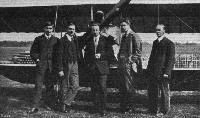 |
Журнал - Flight за 1914 г.
|
| THE CONSTRUCTORS OF THE L. AND P BIPLANE. - From left to right: G. W. Smiles, W. Warren, H. S. Gist (the man who built the nacelle), and M. J. Lindsay.
|
 |
Журнал - Flight за 1915 г.
|
| Brigadier M. #. Franchomme, who has just taken his brevet at the London and Provincial School, Hendon. Brigadier Franchomme is a member of the Belgian King's Guides regiment, and is attached to the Royal Belgian Flying Corps. He was in charge of the Belgian armoured cars in Antwerp.
|
 |
Журнал - Flight за 1915 г.
|
| General Lewis Hall, C.B., who has just taken his Royal Aero Club ticket at the London and Provincial School, Hendon, on an L. and P. biplane. General Hall, whose age is 62, most certainly is an instance contradicting the generally accepted theory that flying is a young man's game.
|
 |
Журнал - Flight за 1915 г.
|
| Three-quarter front view of the L. and P. biplane.
|
 |
M.Goodall, A.Tagg - British Aircraft before the Great War /Schiffer/
|
| L & P (London & Provincial) biplane was of Caudron type built at Hendon in 1914 and later.
|
 |
Журнал - Flight за 1915 г.
|
| Three-quarter rear view of the L. and P. biplane.
|
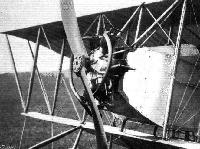 |
Журнал - Flight за 1915 г.
|
| The 35-40 h.p. Anzant engine on the L. and P. biplane.
|
 |
Журнал - Flight за 1915 г.
|
| AT EVENTIDE. - An advanced pupil of the London and Provincial School flying at sunset at Hendon.
|
 |
Журнал - Flight за 1915 г.
|
| The finish of a fine spiral vol plane by Mr. J. H. Moore at Hendon.
|
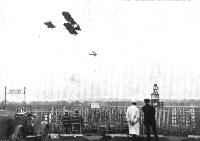 |
Журнал - Flight за 1915 г.
|
| NECK AND NECK PAST THE ENCLOSURES AT HENDON. - Mr. J. H. Moore on his biplane, and Blackburn BE.2c.
|
 |
Журнал - Flight за 1915 г.
|
| Mr. J. H. Moore flying at Hendon Aerodrome on his biplane. On the ground a Blackburn B.E.2C just landed.
|
 |
Журнал - Flight за 1915 г.
|
| Sketch showing nacelle of the L. and P. biplane.
|
 |
Журнал - Flight за 1915 г.
|
| A spar hinge on the L. and P. biplane.
|
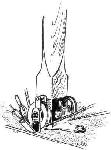 |
Журнал - Flight за 1915 г.
|
| Sttut socket and warp cable pulleys on the L. and P. biplane.
|
 |
Журнал - Flight за 1915 г.
|
| The hinged joint of the top plane extensions on the L. and P. biplane.
|
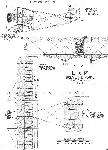 |
Журнал - Flight за 1915 г.
|
| THE L. AND P. BREVET BIPLANE. - Plan, side and front elevation to scale.
|



















